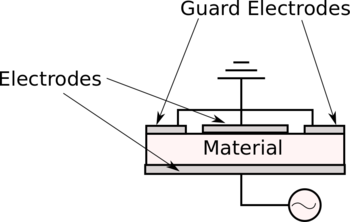Difference between revisions of "Permittivity and Permeability of Materials Obstacle Course"
(→Permittivity of a Lossless Material From a Capacitance Measurement) |
(→Activities) |
||
| Line 27: | Line 27: | ||
[[File:Epsiloncap1.png |right |350px]] | [[File:Epsiloncap1.png |right |350px]] | ||
| − | # Place three samples (air, Teflon, glass) between the aligned and polished ends of two 3/8" diameter, 1/2" lengths of 6061 Al rods (as shown at right). <math>d</math> should be on the order of 1 mm. Measure the capacitances and, from the known surface area <math>A</math> and spacing <math>d</math>, determine the material's relative permittivity. <math>C = \epsilon_r \epsilon_0 \frac{A}{d}</math>. | + | # Place three samples (air, Teflon, glass) between the aligned and polished ends of two 3/8" diameter, 1/2" lengths of 6061 Al rods (as shown at right). <math>d</math> should be on the order of 1 mm. Measure the capacitances and, from the known surface area <math>A</math> and spacing <math>d</math>, determine the material's relative permittivity. <math>C = \epsilon_r \epsilon_0 \frac{A}{d}</math> (for a capacitor with no fringing fields). |
# How do your measured permittivity values compare to standard reference values? | # How do your measured permittivity values compare to standard reference values? | ||
| + | # [https://phet.colorado.edu/sims/html/charges-and-fields/latest/charges-and-fields_en.html Use this web applet to build a capacitor and observe the field lines ]. Are there fringing fields? | ||
<math>\epsilon_r</math>(air): 1.000536<br> | <math>\epsilon_r</math>(air): 1.000536<br> | ||
<math>\epsilon_r</math>(Teflon): 2.1<br> | <math>\epsilon_r</math>(Teflon): 2.1<br> | ||
<math>\epsilon_r</math>(glass): 3.7-10<br> | <math>\epsilon_r</math>(glass): 3.7-10<br> | ||
| + | |||
| + | === A Better Permittivity-Capacitance Measurement of a lossless Material === | ||
| + | |||
| + | [[File:Epsiloncap2.png |right |350px]] | ||
| + | # [https://phet.colorado.edu/sims/html/charges-and-fields/latest/charges-and-fields_en.html Use this web applet to build a ''guarded-electrode'' capacitor (as shown at the right) and observe the field lines ]. Are there fringing fields? | ||
| + | # Measure the three permittivities (air, Teflon, glass) again using this guarded-electrode setup. | ||
| + | # How do these results compare to your first (unguarded) measurements? | ||
| + | # How do these results compare to the standard values? | ||
Revision as of 13:34, 16 May 2018
PAGE UNDER CONSTRUCTION
Contents
Permanent Materials
- 6061 3/8" Al rod stock
- Teflon
- Glass microscope slide
- HP Signal Generator (DC-1 GHz)
- Oscilloscope (at least 1GHz bandwidth)
- Miscellaneous electrical components
Materials to Borrow When Necessary
- Milling machine
- Lathe
Activities
Reading
- Read the Wikipedia articles on permittivity and permeability. With the help of the instructor or TA try to achieve a physical understanding of just what the permittivity and permeability mean in a bulk material.
- Read the first three sections of this paper (pages 1-27). Pay particular attention to the permittivity () / capacitance and permeability () / inductance associations.
Permittivity of a Lossless Material From a Capacitance Measurement
- Place three samples (air, Teflon, glass) between the aligned and polished ends of two 3/8" diameter, 1/2" lengths of 6061 Al rods (as shown at right). should be on the order of 1 mm. Measure the capacitances and, from the known surface area and spacing , determine the material's relative permittivity. (for a capacitor with no fringing fields).
- How do your measured permittivity values compare to standard reference values?
- Use this web applet to build a capacitor and observe the field lines . Are there fringing fields?
(air): 1.000536
(Teflon): 2.1
(glass): 3.7-10
A Better Permittivity-Capacitance Measurement of a lossless Material
- Use this web applet to build a guarded-electrode capacitor (as shown at the right) and observe the field lines . Are there fringing fields?
- Measure the three permittivities (air, Teflon, glass) again using this guarded-electrode setup.
- How do these results compare to your first (unguarded) measurements?
- How do these results compare to the standard values?







